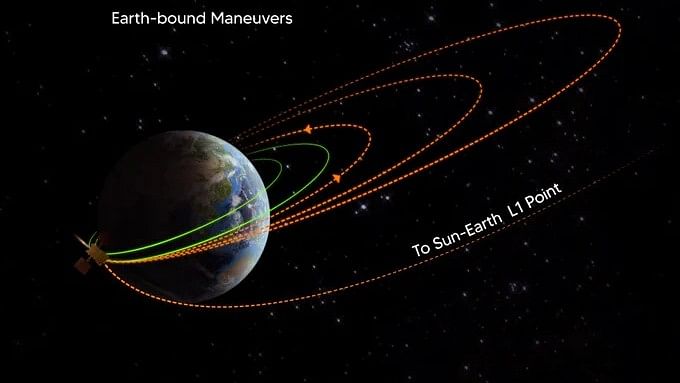
Aditya-L1 performs second earth-bound manoeuvre.
Credit: X/@isro
The Indian Space Research Organisation (ISRO) is planning to carry out analyses to determine a safe orbit for Aditya-L1 around Lagrange point 1 from where it would observe the sun.
Aditya-L1, India’s first space-based observatory to study the sun, left earth-bound orbits for its 110-day journey to the L1 point, on September 18. In an assessment of the space situation around L1, ISRO noted that four operational spacecraft are currently stationed at the L1 point. It said though there is a vast separation between these spacecraft, a close approach assessment at the Lagrange Point Orbit (LPO) is “desirable” because of the large positional uncertainty and sensitivity to other perturbative forces.
“OD (Orbit Determination) for LPO requires tracking data collection over an extended period of time, typically a few days. The typical OD accuracy is of the order of a few km. For Aditya L1 mission, ISRO plans to carry out such analysis periodically to ensure safety and avoid any possibility of close approaches with other neighbouring spacecraft, with the support from NASA-JPL,” the space agency said.
Four spacecraft, including three from NASA, are currently operational at the sun-earth system L1 point – NASA’s WIND (at L1 point since November 2020), ACE (Advanced Composition Explorer, since September 1997), and DSCOVER (Deep Space Climate Observatory, since June 2015), and ESA/NASA’s SOHO (Solar and Heliospheric Observatory, since February 1996).
“These spacecraft at Sun-Earth L1 point provide vital early warnings on adverse space weather events that help protect orbiting space assets and ground-based infrastructure,” ISRO said.
L1 is one of the five Lagrange points where the gravitational force of the two primary bodies (sun and earth) precisely equals the centripetal force required for a small object (the spacecraft) to move with these bodies. This positioning gives the spacecraft the advantage of minimal orbit corrections and fuel requirements.
Aditya-L1, launched on September 2, carries seven payloads designed to closely study the sun through multiple observation channels. The spacecraft will operate in a halo orbit around L1, located approximately 1.5 million kilometres from the earth.